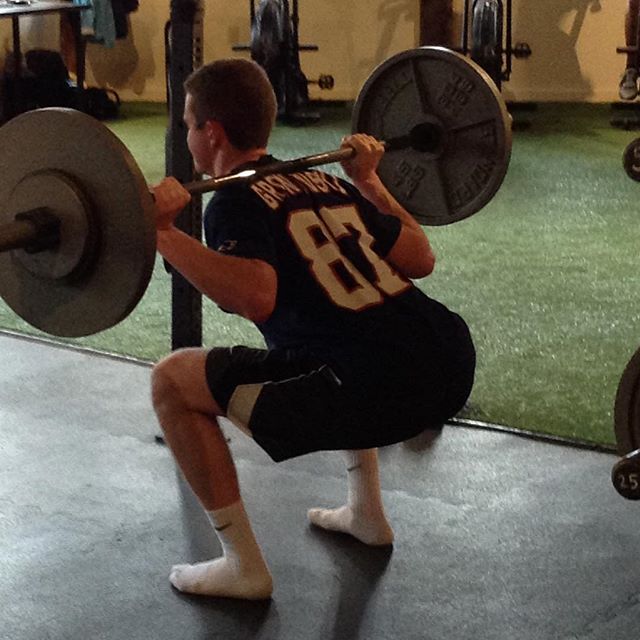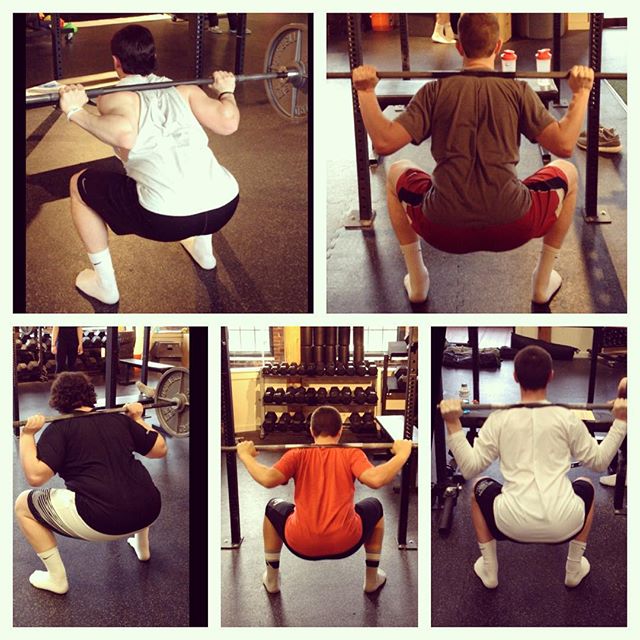Squats when done correctly, are amazing for strength, joint health, bone density, hypertrophy and performance. Also, they are not bad for your knees! Let’s stop blaming your bad knees for why you can’t squat and go over some common squatting issues!

Maybe it’s not that you can’t squat, but perhaps your squats simply just don’t feel good or “right.” Or you’re getting injured. Or you aren’t getting stronger. Whatever the issue, you’re having a tough time squatting.
Let’s talk about 7 common reasons you can’t squat properly so you can start reaping the benefits of this amazing exercise asap.
7 Common Reasons You Can’t Squat
1. Limited Ankle Dorsiflexion
Normal range of motion for ankle dorsiflexion is 20°.
Ankle dorsiflexion can be restricted for many reasons, but I’ll go over a few of the most common below.
—> First, test it out.
How’s your ankle mobility?
See how far the knee can travel over the fourth toe while the heel remains down. If you are able to reach the knee roughly 4 inches over the toe, you have adequate dorsiflexion and your ankle mobility is most likely not the limiting factor contributing to your squatting issues.
Limited Ankle Dorsiflexion Reason 1: Restriction in Front of the Ankle
To achieve optimal dorsiflexion in the ankle, the tibia should slide forward over the Talus. Often times bone spurs, soft tissue restrictions or scar tissue can restrict the anterior joint capsule.
Here is a great ankle mobility drill that might help with a restriction in the ankle:
Limited Ankle Dorsiflexion Reason 2: Tight Calves
Often times people with a tight gastroc/soleus complex have limited ankle dorsiflexion. The usual culprit? Trigger points in the calves. A simple way to address this is by some basic foam rolling, but nothing beats the hands of a skilled muscular therapist when it comes to nasty trigger points. Spend some time with the foam roller, find some tender areas and slowly roll them out. Don’t hold your breath and be sure to breath in a relaxed fashion.
Limited Ankle Dorsiflexion Reason 3: Previous Injury in the Ankle
Regardless of the ankle injury, swelling, bruising and pain will alter the ankle’s function. After the injury, the area will become swollen as a way to help your body stabilize the area and prevent further damage. As the healing process post-injury begins, it’s important to regain ankle mobility. Sometimes dorsiflexion is neglected in the rehab process and never fully restored.
Limited Ankle Dorsiflexion Reason 4: Poor Tissue Quality/Adhesions Near/Around Achilles
I’ve worked with a handful of clients who’ve experienced a multiple small juries to their achilles tendon. When this happens, adhesions start to develop and the tissue over the achilles can no longer slide properly. When the skin cannot slide smoothly over the fascia, you guessed it – ankle restrictions occur.
Here’s a great video describing Graston technique treatment for achilles tendon injury:
2. Flat Feet
While it’s still possible to squat with flat feet, people with neutral feet will find squatting easier. Often times, flat feet are weak feet. Anytime you lose stability in your foot, it can compromise optimal mechanics in any of joints above.
The most common issue I see in people with flat feet who attempt to squat, is that their arch collapses and their knees moved into a valgus position. Keep in mind, this is not optimal for any lower body movements.
3. Poor hip mobility
I know this is a pretty generic statement, but if you have poor hip mobility in general, squatting is going to be tough…or at least toughER.
If you wan to improve your overall hip mobility, check this video out!
4. Your Squatting Technique Doesn’t Match your Hip Architecture
Everyone is built differently. Thus, it makes sense that we do (and should) squat differently based on our anatomy. The shape of your pelvis and femoral head will absolutely play a roll in determining your squat mechanics.

This article will fill you in. It’s an absolute game changer.
Why People Must Have Different Squat Stances
5. Weak Anterior Core
You’d would be hard-pressed to find someone who squats very heavy and has weak abdominals. The ability to create intra-abdominal pressure is vital to maintaining a healthy spine position for the duration of the squat.
Rib cage position in relationship to the pelvis plays a large role in core stability. If you imagine the pelvis as a bucket, you want to find an optimal position throughout the squat where you do not spill any water out of the bucket. Dump it too far forward or back and you’re not able to create optimal intra-abdominal pressure.
6. Threat Response
You’ve probably heard this called the fight or flight response. To put it simply, for some reason, your nervous system perceives squatting as a threatening movement. When this happens, your nervous system “puts the brakes on movement” and this essentially limits your ability to squat properly.
This can stem from a number of things. Perhaps you injured yourself squatting in the past or you haven’t squatted in years. This response can be your body’s way of saying it doesn’t like the idea of the squat pattern, at least not at this current time.
You can tell whether or not your body views squatting as a threat by things like increased heart rate, flushed skin, increased breathing rate or shaking.
If any of these things occur with just the mention of getting your squat on, it’s probably not the best time.
7. Terrible Technique
This might seem obvious, but you wouldn’t believe how many people squat with awful technique. Regardless of why you squat horribly, a seasoned strength coach should be able to help you improve in your squat technique.
There are so many various reasons why you could be having trouble with the squat pattern and these are just a handful. The goal of today’s blog is to open your eyes to a few reasons you may be having a tough time and give you a few ideas of why you can’t squat…at least not the way you want to squat.

Great stuff here Matt. Glad that the article on the PTDC helped as well.
*Mike – I suck. Good work man.
Jonathan- that article on PTDC was a game changer. Thank you for sharing such great info!
-Mike